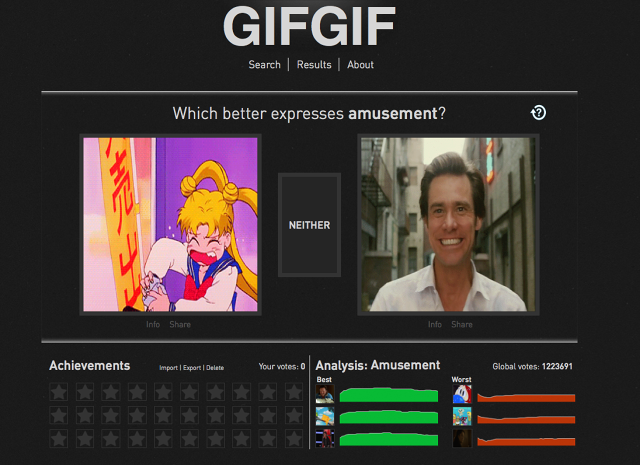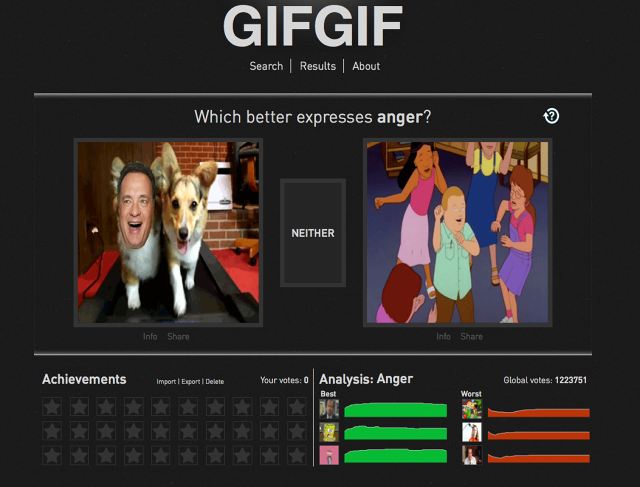Which GIF better expresses happiness? This one of Ren and Stimpy bouncing up and down, or this one of Lost's John Locke grinning with an orange slice in his mouth? Does your opinion change if Grumpy Cat is added in? These seemingly trivial questions about how you perceive animated GIFs is the central task of GIFGIF, a project from MIT Media lab that isn't just a fun web game, but a first step toward building up a universal library of non-verbal communication.
GIFGIF was born out of a series of conversations over the watercooler at MIT between Kevin Hu, a first year master's student studying data visualization and network analysis, and Travis Rich, a first year PhD student with a background in electric engineering. Although Hu and Rich don't have the same credentials, they were both fascinated by the power of non-verbal communication.

"While a GIF might not say anything in words, you immediately know what it's supposed to mean," Rich tells Co.Design. "It's an incredibly diverse medium, that can express everything from the sadness you might feel when your boyfriend breaks up with you, to 'holy crap, is this the greatest burrito I've ever had in my life!'"
Inspired by the approach of Place Pulse, a previous MIT Media Lab joint that used Google Street View to try to analyze why we feel certain cities are safer, artier, or more modern than others, Hu and Rich wanted to start a site that did that same thing, not with neighborhoods, but with Spongebob Squarepants, dramatic gophers, and the like.
The result is GIFGIF, a seemingly silly timewaster that is actually a serious attempt to build up a library of quantitative data about how we perceive the expressions and facial tics of others.

By going to the site, users are presented with two GIFs randomly plucked from a library of thousands, then asked which better expresses certain emotive concepts like guilt, relief, anger, and more. If the GIF of Monty Burns twiddling his fingers and saying "excellent" expresses pleasure better than a loop of the Lady and the Tramp touching lips in the middle of a strand of spaghetti, you click on Burns, and another two GIFs load up. If neither GIF seems to express the concept, you click "Neither" and move on.
Like playing an Xbox game, you can win achievements for voting on GIFs, and the GIFs that best (or least) express the emotion being voted upon are tracked in real-time rankings on the bottom of the page. But while GIFGIF plays like a web game, its goals are serious: it wants to be a tool people can use to bridge the language gap.

"At the beginning of the project, we thought of GIFGIF primarily as a research tool," says Rich. "For example, is shame harder to pinpoint than happiness? Or if Germans think shame looks different than Americans, what does that mean?" Over time, though, GIFGIF has taken on a life of its own as an emotion search engine, which opens exciting new possibilities. "Our next step is to build out an API, so that developers can use GIFGIF in their apps."
And what would developers do with it? Imagine an email app with natural language processing that could send an email to someone in China, just by translating your text into GIFs. Or imagine an infinitely nuanced emoji library, with a custom GIF for every conceivable emotion you want to express.
"We started GIFGIF as a side project, but a lot of people are really taking it seriously," Hu says. "It's becoming an important medium of communication, yet, so far, there haven't been many tools to seriously make use of it as such. No one will be able to write the constitution in GIFs any time soon, but we want to do our part to make the GIF truly universal."
You can play GIFGIF for yourself here.